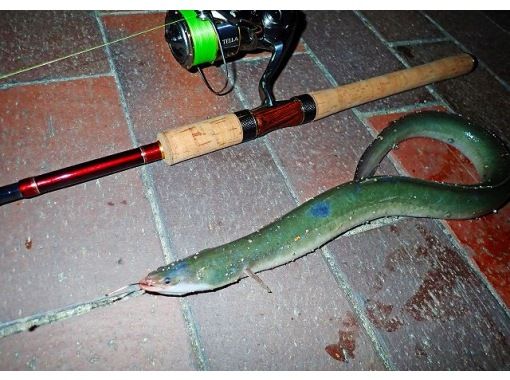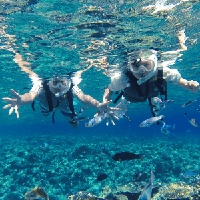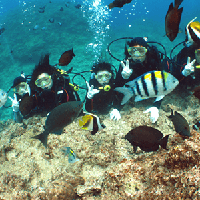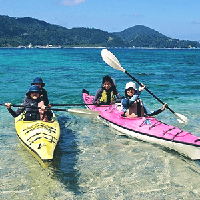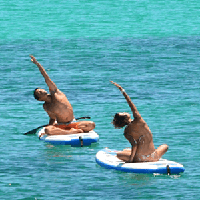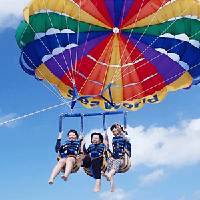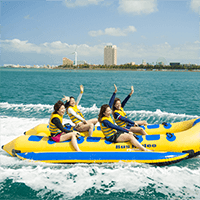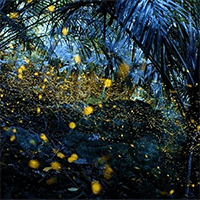River fishing / Stream fishing in Japan
- Age 3~Age 100
- 1~2 hours
- 07:00 / 16:00
Meet at Chofu Station or Fukadai Fureai no Sato and go around 6 spots in the Nogawa River on an electric bicycle (with front and rear child seats, children's bicycles are available in various sizes). The tour lasts 2 hours. In the first half, you will fish for carp and catfish with bread. Even children can easily catch them, but the average size is about 60 cm, so you may not be able to catch them. The pull is strong, so please do your best to catch them. In the second half, if the fishing conditions are not good, you will experience searching the river in waders (free fool boots) or marine shoes. The creatures that can be caught are mainly Japanese mitten crabs, Moroko, Minnows, Japanese chibu, Yoshinobori, loach, Ukigori, black killifish, crayfish, and turtles. You can also take them home. What to bring: Marine shoes (from the end of March to October), swimsuit, spats, rash guard, change of clothes, hat, drink, sneakers, plastic case for taking things home + bubble tea (can be sold on-site) What to bring: Rubber boots (from November to mid-March), fishing equipment, bait, rubber boots, net, storage bucket, explanation panel for animals We look forward to your participation. Nogawa Nature School Sonoda (Tosshi)
参加人数が1人だったのでマンツーマンでの体験になりました。釣り初心者ですが、丁寧なサポートをしていただいたので、大きな鯉を釣ることが出来ました!釣りのコツなども教えてもらい、またやりたいと思いました!後半はガサガサ体験をして、たくさんの種類のハゼ、ヤゴ、ザリガニ、エビ、貝などを発見することができ、テンションMAXでした!!また利用したいです!!
- Age 4~Age 100
- 1~2 hours
- 05:00 / 05:30 / 06:00 / 06:30 / 07:00 / 07:30 / 08:00 / 08:30 / 09:00 / 09:30 / 10:00 / 10:30 / 11:00 / 11:30 / 12:00 / 12:30 / 13:00 / 13:30 / 14:00 / 14:30 / 15:00 / 15:30 / 16:00 / 16:30 / 17:00
The fish is just delicious! This is a fishing pond. You can enjoy fishing in a natural environment using meltwater from the Zao mountain range. The five ponds have clear water that makes the fish's patterns clearly visible. The stream that runs through the premises plays a beautiful sound. You can eat the fish you catch on the spot, salt-grilled or fried, or take them home. You can also eat and drink while fishing. In addition to char, yamame, and rainbow trout raised in Zao, there is also coho salmon, a specialty of Miyagi Prefecture. A wide range of fish are released, from small ones with a body length of 10 cm to ones over 70 cm and 5 kg. You can come empty-handed, and even complete beginners can catch an average of six fish. Everyone can enjoy it, regardless of gender, whether they are children or adults. In addition to set meals such as sashimi and fried fish you caught, the attached cafe is popular for its ``Earth's Dashi Pork Soup'' and ``Zao Natural Water Shaved Ice.'' Enjoy it while drinking beer in the summer, and warm yourself up with the special soup in the winter.
- Age 4~Age 100
- 2~3 hours
- 05:00 / 05:30 / 06:00 / 06:30 / 07:00 / 07:30 / 08:00 / 08:30 / 09:00 / 09:30 / 10:00 / 10:30 / 11:00 / 11:30 / 12:00 / 12:30 / 13:00 / 13:30 / 14:00 / 14:30 / 15:00 / 15:30 / 16:00 / 16:30 / 17:00
The fish is simply delicious! This is a fishing pond. You can enjoy fishing in a natural environment using meltwater from the Zao mountain range. The five ponds have water so clear that you can clearly see the patterns of the fish. The stream that runs through the premises plays a beautiful sound. You can grill the fish you catch yourself over charcoal. In addition to charcoal-raised char, yamame, and rainbow trout in Zao, there is also coho salmon, a specialty of Miyagi Prefecture. A wide range of fish are released, from small ones with a body length of 10 cm to ones over 70 cm and 5 kg. You can come empty-handed, and even a complete beginner can catch an average of six fish. Everyone, regardless of gender, children or adults, can enjoy the experience. The speciality pork soup and rice balls are included.
- Age 3~Age 70
- 2~3 hours
- 09:00 / 11:30 / 14:00 / 16:30
Held from spring to autumn Fishing for Japanese eels in the brackish waters of rivers Part 1: 8:00-10:30 Part 2: 10:30-13:00 Part 3: 13:30-16:00 Part 4: 16:00-18:30 This is a tour to fish for eels at the mouths of rivers that run through Tokyo. Japanese eels are born in the western waters of the Mariana Islands. They grow in rivers not only in Japan but also in East Asia, including China, Taiwan, and the Korean Peninsula, and are known to return to the Mariana Islands to spawn. Japanese eels (Anguilla japonica), which belong to the Anguilla genus of the eel family, are widely distributed in East Asia, including Japan, China, Taiwan, and Korea. In Japan, they mainly live south of Honshu, but there have been cases of them being caught in Hokkaido. Rental tackle, fishing rod, and equipment are included, so you can participate empty-handed. Two patterns of fishing will be done: casting fishing and plastic bottle tackle fishing, using earthworms as bait. While waiting for the tackle, you can fish for goby at your feet. The main target is eels, but sometimes you can also catch goby, crabs, and seigo. The tour lasts about 3 hours. Please bring a headlamp, a handy light, and drinks. *If you want to take the fish home, please bring an aeration device (battery-powered bubbler) to prevent oxygen deficiency, a plastic case or fishing bucket to prevent escape, and a cooler box. By train: 15 minutes walk from JR Joban Line or Tokyo Metro Chiyoda Line By car: Please use a nearby parking lot Meeting place: Near the Seven-Eleven Katsushika Kosuge 1-chome store. We will send you a map in advance, so please walk to the point. Migration of Japanese eels Japanese eels spawn in the summer in the waters west of the Mariana Islands in the Pacific Ocean. After hatching, they become willow-leaf-shaped larvae called leptocephalus. Glass eels are carried by ocean currents and reach East Asia in about six months, then transform into long, cylindrical glass eels and ride the high tide into rivers. After that, their transparent bodies start to take on color, and they are called yellow eels. During the yellow eel stage, eels grow large, and eat a variety of foods, including shrimp, crabs, small fish, and insects. The environment in which Japanese eels spend their growth period is wide, from coastal areas to the upper reaches of rivers, and includes not only freshwater areas but also brackish water and seawater. After several years to a dozen years, when they grow to a size of about 40 cm or more for males and about 50 cm or more for females, they begin to mature and are called silver eels. Silver eels leave their familiar rivers and coastal areas and travel to spawning grounds from autumn to winter. They reach the spawning grounds in the Marianas in about six months, spawn, and then end their life. PS: The minimum number of participants is 5 or more.
最近チェックしたプラン
Please wait a moment
![[Tokyo/Chofu] Fishing with Nogawa bread ears from 7:00 AM, 16:00 PM. 80cm class, second half, you can experience the rustling of the river (free rental of Baka boots electric bicycle)の画像](https://img.activityjapan.com/10/47214/10000004721401_atFOJjl6_3.png?version=1707260042)
![[Miyagi, Shiroishi/Zao] Fishing Pond Cafe Clover "Eat Plan"の画像](https://img.activityjapan.com/10/57513/10000005751301_qgEqCyiL_3.jpg?version=1737346802)
![[Miyagi, Shiroishi/Zao] Fishing Pond Cafe Clover "Barbecue Plan"の画像](https://img.activityjapan.com/10/57515/10000005751501_qgEqCyiL_3.JPG?version=1740745922)
